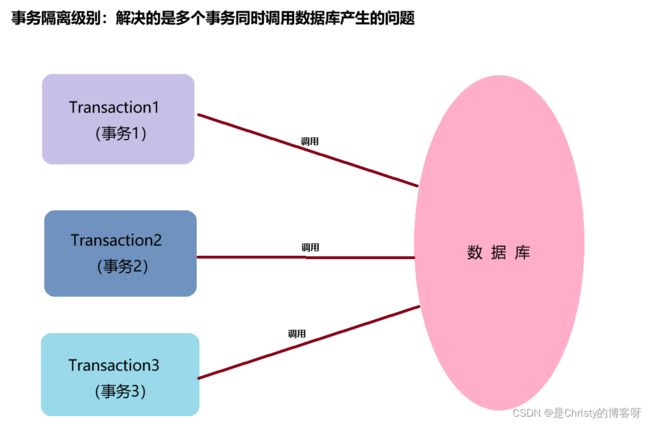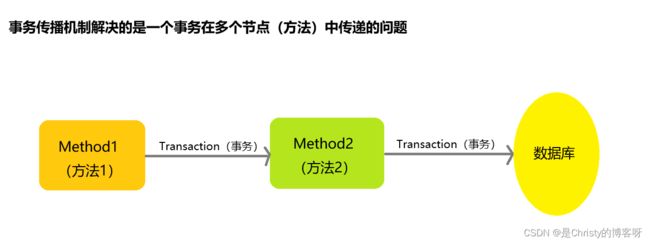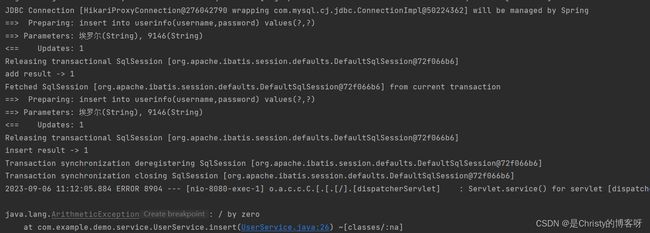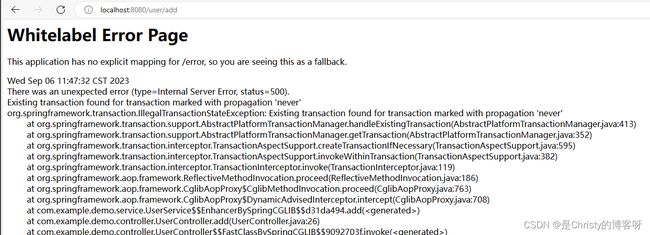【Spring 事务和事务传播机制】
目录
1 事务概述
1.1 为什么需要事务
1.2 事务的特性
1.3 Spring 中事务的实现
2 Spring 声明式事务
2.1 @Transactional
2.2 @Transactional 的作用范围
2.3 @Transactional 的各种参数
2.3.1 ioslation
2.4 事务发生了异常,也不回滚的情况
异常被捕获时
3 事务的传播机制
3.1 定义
3.2 为什么需要事务传播机制
3.3 事务传播机制种类
Propagation.REQUIRED
Propagation.SUPPORTS
Propagation.MANDATORY
Propagation.REQUIRES_NEW
Propagation.NOT_SUPPORTED
Propagation.NEVER
Propagation.NESTED
1 事务概述
1.1 为什么需要事务
事务定义
将⼀组操作封装成⼀个执⾏单元(封装到⼀起),要么全部成功,要么全部失败。
对于转账来说:
第一步操作:A 账户 -1000 元
第二步操作:B 账户 +1000 元
使用了事务之后,这一组操作要么一起执行成功,要么一起失败。如果没有事务的情况下,有可能第一步成功了,第二步失败了,那么对于 A 来说,它的账户的 1000 块钱就人间蒸发了。
1.2 事务的特性
事务有4 ⼤特性(ACID),原⼦性、持久性、⼀致性和隔离性,具体概念如下:
原⼦性(Atomicity):⼀个事务(transaction)中的所有操作,要么全部完成,要么全部不完成,不会结束在中 间某个环节。事务在执⾏过程中发⽣错误,会被回滚(Rollback)到事务开始前的状态,就像这个 事务从来没有执⾏过⼀样。
⼀致性(Consistency):在事务开始之前和事务结束以后,数据库的完整性没有被破坏。这表示写⼊的资料必须完 全符合所有的预设规则,这包含资料的精确度、串联性以及后续数据库可以⾃发性地完成预定的⼯ 作。
隔离性(Isolation):数据库允许多个并发事务同时对其数据进⾏读写和修改的能⼒,隔离性可以防⽌多个事务 并发执⾏时由于交叉执⾏⽽导致数据的不⼀致。事务隔离分为不同级别,包括读未提交(Read uncommitted)、读提交(read committed)、可重复读(repeatable read)和串⾏化 (Serializable)。
持久性(Durability):事务处理结束后,对数据的修改就是永久的,即便系统故障也不会丢失。
1.3 Spring 中事务的实现
Spring 中事务操作分为两类:
1. 编程式事务(手动写代码操作事务)
2. 声明式事务(利用注解自动开启和提交事务)
2 Spring 声明式事务
MySQL 中,事务有三个重要的操作:开启事务、提交事务、回滚事务,对应的操作命令如下:
-- 开启事务
start transaction;
-- 业务执行
-- 提交事务
commit;
-- 回滚事务
rollback;
而 Spring 声明式事务的实现与 MySQL 事务的实现基本一致,只是前者自动的,只需要在需要的⽅法上添加 @Transactional 注解就可以实现了,⽆需⼿动开启事务和提交事务,进⼊⽅法时⾃动开启事务,⽅法执⾏完会⾃动提交事务,如果中途发⽣了没有处理的异常会⾃动回滚事务。
2.1 @Transactional
package com.example.demo.model;
import lombok.Data;
import java.time.LocalDateTime;
@Data
public class UserInfo {
private int id;
private String username;
private String password;
private String photo;
private LocalDateTime createtime;
private LocalDateTime updatetime;
private int state;
}
package com.example.demo.mapper;
import com.example.demo.model.UserInfo;
import org.apache.ibatis.annotations.Insert;
import org.apache.ibatis.annotations.Mapper;
@Mapper
public interface UserMapper {
@Insert("insert into userinfo(username,password) values(#{username},#{password})")
int add(UserInfo userInfo);
}
package com.example.demo.service;
import com.example.demo.mapper.UserMapper;
import com.example.demo.model.UserInfo;
import org.springframework.beans.factory.annotation.Autowired;
import org.springframework.stereotype.Service;
@Service
public class UserService {
@Autowired
private UserMapper userMapper;
public int add(UserInfo userInfo){
return userMapper.add(userInfo);
}
}
package com.example.demo.controller;
import com.example.demo.model.UserInfo;
import com.example.demo.service.UserService;
import org.springframework.beans.factory.annotation.Autowired;
import org.springframework.transaction.annotation.Transactional;
import org.springframework.web.bind.annotation.RequestMapping;
import org.springframework.web.bind.annotation.RestController;
@RequestMapping("/user")
@RestController
public class UserController {
@Autowired
private UserService userService;
@RequestMapping("/add")
@Transactional
public int add(){
// 1. 非空判断
UserInfo userInfo = new UserInfo();
userInfo.setUsername("莉丝");
userInfo.setPassword("6363");
// 2. 调用 service 执行添加
int result = userService.add(userInfo);
System.out.println("result:"+result);
int num = 10/0;
// 3. 将结果给前端
return 0;
}
}
启动项目发现,使用了 @Transactional 注解的确回滚了事务:
 可以看到,信息并没有添加到数据库的 userinfo 这表里。
可以看到,信息并没有添加到数据库的 userinfo 这表里。
2.2 @Transactional 的作用范围
@Transactional 可以用来修饰方法或类,修饰方法时,只能应用到 public 方法上,其他访问权限均不生效;修饰类时,该注解对该类中所有的 public 方法都生效。
2.3 @Transactional 的各种参数
| 参数 | 作用 |
| value | 配置多个事务管理器时,使用该属性指定一个事务管理器 |
| transactionManager | |
| propagation | 事务的传播行为,默认值为 Propagation.REQUIRED |
| isolation | 事务的隔离级别,默认值为 Isolation.DEFAULT |
| timeout | 事务的超出时间,默认值为 -1。如果超出该时间限制但事务还没有完成,则自动回滚事务 |
| readOnly | 是否为只读事务,默认值为 false; |
| rollbackFor | 指定触发事务回滚的异常类型,可以多个 |
| rollbackForClassName | 指定触发事务回滚的异常类名称,可以多个 |
| noRollbackFor | 指定不回滚事务的异常类型,可以多个 |
| noRollbackForClassName | 指定不回滚事务的异常类名称,可以多个 |
2.3.1 ioslation
根据文章开头的介绍,我们知道事务有四大特性,分别是原子性、一致性、隔离性以及持久性。而这四大特性中,只有隔离性,也就是隔离级别是可以设置的。
事务的隔离级别是用来保障多个并发事务执行更加可控,更符合程序员的预期。
在 Spring 中,可以通过 @Transactional 中的 isolation 属性进行设置。
MySQL 事务隔离级别:
1. READ UNCOMMITTED:读未提交,该隔离级别的事务可以看到其他事务中未提交的数据,⽽未提交的数据可能会发⽣回滚,因此我们把该级别读取到的数据称之为脏数据,把这个问题称之为脏读。
2. READ COMMITTED:读已提交,该隔离级别的事务能读取到已经提交事务的数据, 因此它不会有脏读问题。但由于在事务的执⾏中可以读取到其他事务提交的结果,所以在不同时间的相同 SQL 查询中,可能会得到不同的结果,这种现象叫做不可重复读。
3. REPEATABLE READ:可重复读,是 MySQL 的默认事务隔离级别,它能确保同⼀事务多次查询的结果⼀致,这就意味着,该级别的事务 A 正在执行,而另一个事务 B 成功插入了一条数据,但由于可重复读要保证每次查询的结果一致,所以 A 就会查询不到这条数据,但是 A 也想插入这条数据,却发现插入不了,这就是幻读。
4. SERIALIZABLE:序列化,事务最⾼隔离级别,它会强制事务排序,使之不会发⽣冲突,从⽽解决了脏读、不可重复读和幻读问题,但因为执⾏效率低,所以真正使⽤的场景并不多。
| 事务隔离级别 | 脏读 | 不可重复读 | 幻读 |
| 读未提交 | ✔ | ✔ | ✔ |
| 读已提交 | × | ✔ | ✔ |
| 可重复读 | × | × | ✔ |
| 串行化 | × | × | × |
● 脏读:⼀个事务读取到了另⼀个事务修改的数据之后,后⼀个事务⼜进⾏了回滚操作,从⽽导致第⼀个事务读取的数据是错误的。
● 不可重复读:⼀个事务两次查询得到的结果不同,因为在两次查询中间,有另⼀个事务把数据修改了。
● 幻读:⼀个事务两次查询中得到的结果集不同,因为在两次查询中另⼀个事务有新增了⼀部分数据。
不同的数据库的隔离级别是不一样的,MySQL 有四种,Oracle 有三种。Spring 的隔离级别为五种,是为了兼容不同的数据库。
Spring 中事务隔离级别包含以下 5 种:
1. Isolation.DEFAULT:以连接的数据库的事务隔离级别为主。
2. Isolation.READ_UNCOMMITTED:读未提交,可以读取到未提交的事务,存在脏读。
3. Isolation.READ_COMMITTED:读已提交,只能读取到已经提交的事务,解决了脏读,存在不可重复读。
4. Isolation.REPEATABLE_READ:可重复读,解决了不可重复读,但存在幻读(MySQL默认级别)。
5. Isolation.SERIALIZABLE:串⾏化,可以解决所有并发问题,但性能太低。
如果 Spring 的隔离级别与 MySQL 设置的隔离级别不同的时候,以 Spring 设置的隔离级别为主。
Spring 相当于一个客户端,设置了,以 Spring 设置的为主,没有设置时,跟连接的数据库的隔离级别一样,也就是 DEFAULT。
隔离级别枚举的值以 2 的次方,性能更高。
2.4 事务发生了异常,也不回滚的情况
异常被捕获时
package com.example.demo.controller;
import com.example.demo.model.UserInfo;
import com.example.demo.service.UserService;
import org.springframework.beans.factory.annotation.Autowired;
import org.springframework.transaction.annotation.Transactional;
import org.springframework.web.bind.annotation.RequestMapping;
import org.springframework.web.bind.annotation.RestController;
@RequestMapping("/user")
@RestController
public class UserController {
@Autowired
private UserService userService;
@RequestMapping("/add")
@Transactional
public int add(){
// 1. 非空判断
UserInfo userInfo = new UserInfo();
userInfo.setUsername("莉丝");
userInfo.setPassword("6363");
// 2. 调用 service 执行添加
int result = userService.add(userInfo);
System.out.println("result:"+result);
try{
int num = 10/0;
}catch (Exception e){
}
// 3. 将结果给前端
return 0;
}
}
@Transactional 是AOP,出现异常的时候,代理对象可以感知到异常,并进行事务的回滚。但如果异常被捕获了,外部的代理对象就感知不到了,就不会进行事务的回滚了。
对此有两种解决方案。
1. 将异常继续抛出去,让代理对象感知到异常,也就能自动的回滚事务了。
package com.example.demo.controller;
import com.example.demo.model.UserInfo;
import com.example.demo.service.UserService;
import org.springframework.beans.factory.annotation.Autowired;
import org.springframework.transaction.annotation.Transactional;
import org.springframework.web.bind.annotation.RequestMapping;
import org.springframework.web.bind.annotation.RestController;
@RequestMapping("/user")
@RestController
public class UserController {
@Autowired
private UserService userService;
@RequestMapping("/add")
@Transactional
public int add(){
// 1. 非空判断
UserInfo userInfo = new UserInfo();
userInfo.setUsername("埃罗尔");
userInfo.setPassword("9146");
// 2. 调用 service 执行添加
int result = userService.add(userInfo);
System.out.println("result:"+result);
try{
int num = 10/0;
}catch (Exception e){
throw e;
}
// 3. 将结果给前端
return 0;
}
}
2. 使用代码,手动回滚事务
package com.example.demo.controller;
import com.example.demo.model.UserInfo;
import com.example.demo.service.UserService;
import org.springframework.beans.factory.annotation.Autowired;
import org.springframework.transaction.annotation.Transactional;
import org.springframework.transaction.interceptor.TransactionAspectSupport;
import org.springframework.web.bind.annotation.RequestMapping;
import org.springframework.web.bind.annotation.RestController;
@RequestMapping("/user")
@RestController
public class UserController {
@Autowired
private UserService userService;
@RequestMapping("/add")
@Transactional
public int add(){
// 1. 非空判断
UserInfo userInfo = new UserInfo();
userInfo.setUsername("埃罗尔");
userInfo.setPassword("9146");
// 2. 调用 service 执行添加
int result = userService.add(userInfo);
System.out.println("result:"+result);
try{
int num = 10/0;
}catch (Exception e){
TransactionAspectSupport.currentTransactionStatus().setRollbackOnly();
}
// 3. 将结果给前端
return 0;
}
}
在网页没有报错的情况下,进行了事务的回滚。
3 事务的传播机制
3.1 定义
Spring 事务传播机制定义了多个包含了事务的⽅法,相互调⽤时,事务是如何在这些⽅法间进⾏传递的。
3.2 为什么需要事务传播机制
事务隔离级别是保证多个并发事务执⾏的可控性的(稳定性的),⽽事务传播机制是保证⼀个事务在多个调⽤⽅法间的可控性的(稳定性的)。
3.3 事务传播机制种类
Propagation.REQUIRED
默认的事务传播级别,如果当前存在事务,就加入这个事务(加入意味着成为这个外部事务的一部分),如果不存在事务,则会自己创建一个新的事务。与其他被调用的事务,要么一起提交事务,要么一起回滚事务。
package com.example.demo.controller;
import com.example.demo.model.UserInfo;
import com.example.demo.service.UserService;
import org.springframework.beans.factory.annotation.Autowired;
import org.springframework.transaction.annotation.Transactional;
import org.springframework.transaction.interceptor.TransactionAspectSupport;
import org.springframework.web.bind.annotation.RequestMapping;
import org.springframework.web.bind.annotation.RestController;
@RequestMapping("/user")
@RestController
public class UserController {
@Autowired
private UserService userService;
@RequestMapping("/add")
@Transactional
public int add(){
// 1. 非空判断
UserInfo userInfo = new UserInfo();
userInfo.setUsername("埃罗尔");
userInfo.setPassword("9146");
// 2. 调用 service 执行添加
int result = userService.add(userInfo);
System.out.println("result:"+result);
try{
int num = 10/0;
}catch (Exception e){
TransactionAspectSupport.currentTransactionStatus().setRollbackOnly();
}
// 3. 将结果给前端
return 0;
}
}
package com.example.demo.service;
import com.example.demo.mapper.UserMapper;
import com.example.demo.model.UserInfo;
import org.springframework.beans.factory.annotation.Autowired;
import org.springframework.stereotype.Service;
import org.springframework.transaction.annotation.Transactional;
@Service
public class UserService {
@Autowired
private UserMapper userMapper;
@Transactional
public int add(UserInfo userInfo){
int result = userMapper.add(userInfo);
System.out.println("add result -> " + result);
insert(userInfo);
return result;
}
@Transactional
public int insert(UserInfo userInfo){
int result = userMapper.add(userInfo);
System.out.println("insert result -> " + result);
int num = 10 / 0;
return result;
}
}
add 调用两个加了@Transactional 的 service 的方法。
Propagation.SUPPORTS
如果当前存在事务(存在于别的方法开启的事务中,而不是自己启动事务),则加入该事务;如果没有,则以非事务的方式继续运行。
修改 insert 方法如下,添加 propagation 参数:
package com.example.demo.controller;
import com.example.demo.model.UserInfo;
import com.example.demo.service.UserService;
import org.springframework.beans.factory.annotation.Autowired;
import org.springframework.transaction.annotation.Propagation;
import org.springframework.transaction.annotation.Transactional;
import org.springframework.transaction.interceptor.TransactionAspectSupport;
import org.springframework.web.bind.annotation.RequestMapping;
import org.springframework.web.bind.annotation.RestController;
@RequestMapping("/user")
@RestController
public class UserController {
@Autowired
private UserService userService;
@RequestMapping("/add")
@Transactional(propagation = Propagation.SUPPORTS)
public int add(){
// 1. 非空判断
UserInfo userInfo = new UserInfo();
userInfo.setUsername("埃罗尔");
userInfo.setPassword("9146");
// 2. 调用 service 执行添加
int result = userService.add(userInfo);
System.out.println("result:"+result);
try{
int num = 10/0;
}catch (Exception e){
// throw e;
TransactionAspectSupport.currentTransactionStatus().setRollbackOnly();
}
// 3. 将结果给前端
return 0;
}
}
对于上述 add 来说,它并没有存在于任何一个事务当中,所以它按照非事务的方式运行。
package com.example.demo.service;
import com.example.demo.mapper.UserMapper;
import com.example.demo.model.UserInfo;
import org.springframework.beans.factory.annotation.Autowired;
import org.springframework.stereotype.Service;
import org.springframework.transaction.annotation.Propagation;
import org.springframework.transaction.annotation.Transactional;
@Service
public class UserService {
@Autowired
private UserMapper userMapper;
@Transactional(propagation = Propagation.SUPPORTS)
public int add(UserInfo userInfo){
int result = userMapper.add(userInfo);
System.out.println("add result -> " + result);
insert(userInfo);
return result;
}
@Transactional(propagation = Propagation.SUPPORTS)
public int insert(UserInfo userInfo){
int result = userMapper.add(userInfo);
System.out.println("insert result -> " + result);
int num = 10 / 0;
return result;
}
}
service 中, add 被 controller 调用,由于 controller 不存在事务,因此 add 也不存在于任何事务中,所以 add 按照非事务的方式运行,同样对于 insert 来说也是如此,按照非事务的方式运行。
运行结果是:添加了两条信息:
如果 controller 的 add 的事务传播机制改成 Propagation.REQUIRED ,其他两个方法不变,结果会怎么样呢?
package com.example.demo.controller;
import com.example.demo.model.UserInfo;
import com.example.demo.service.UserService;
import org.springframework.beans.factory.annotation.Autowired;
import org.springframework.transaction.annotation.Propagation;
import org.springframework.transaction.annotation.Transactional;
import org.springframework.transaction.interceptor.TransactionAspectSupport;
import org.springframework.web.bind.annotation.RequestMapping;
import org.springframework.web.bind.annotation.RestController;
@RequestMapping("/user")
@RestController
public class UserController {
@Autowired
private UserService userService;
@RequestMapping("/add")
@Transactional(propagation = Propagation.REQUIRED)
public int add(){
// 1. 非空判断
UserInfo userInfo = new UserInfo();
userInfo.setUsername("埃罗尔");
userInfo.setPassword("9146");
// 2. 调用 service 执行添加
int result = userService.add(userInfo);
System.out.println("result:"+result);
try{
int num = 10/0;
}catch (Exception e){
// throw e;
TransactionAspectSupport.currentTransactionStatus().setRollbackOnly();
}
// 3. 将结果给前端
return 0;
}
}
Propagation.MANDATORY
mandatory 强制性的意思。如果当前存在事务,则加入该事务;如果没有事务,则抛出异常。
Propagation.REQUIRES_NEW
表示创建⼀个新的事务,如果当前存在事务,则把当前事务挂 起。也就是说不管外部⽅法是否开启事务,Propagation.REQUIRES_NEW 修饰的内部⽅法会新开 启⾃⼰的事务,且开启的事务相互独⽴,互不⼲扰。
Propagation.NOT_SUPPORTED
以⾮事务⽅式运⾏,如果当前存在事务,则把当前事务挂起。
Propagation.NEVER
以⾮事务⽅式运⾏,如果当前存在事务,则抛出异常。
package com.example.demo.controller;
import com.example.demo.model.UserInfo;
import com.example.demo.service.UserService;
import org.springframework.beans.factory.annotation.Autowired;
import org.springframework.transaction.annotation.Propagation;
import org.springframework.transaction.annotation.Transactional;
import org.springframework.transaction.interceptor.TransactionAspectSupport;
import org.springframework.web.bind.annotation.RequestMapping;
import org.springframework.web.bind.annotation.RestController;
@RequestMapping("/user")
@RestController
public class UserController {
@Autowired
private UserService userService;
@RequestMapping("/add")
@Transactional(propagation = Propagation.REQUIRED)
public int add(){
// 1. 非空判断
UserInfo userInfo = new UserInfo();
userInfo.setUsername("埃罗尔");
userInfo.setPassword("9146");
// 2. 调用 service 执行添加
int result = userService.add(userInfo);
System.out.println("result:"+result);
try{
int num = 10/0;
}catch (Exception e){
// throw e;
TransactionAspectSupport.currentTransactionStatus().setRollbackOnly();
}
// 3. 将结果给前端
return 0;
}
}
package com.example.demo.service;
import com.example.demo.mapper.UserMapper;
import com.example.demo.model.UserInfo;
import org.springframework.beans.factory.annotation.Autowired;
import org.springframework.stereotype.Service;
import org.springframework.transaction.annotation.Propagation;
import org.springframework.transaction.annotation.Transactional;
@Service
public class UserService {
@Autowired
private UserMapper userMapper;
@Transactional(propagation = Propagation.NEVER)
public int add(UserInfo userInfo){
int result = userMapper.add(userInfo);
System.out.println("add result -> " + result);
insert(userInfo);
return result;
}
@Transactional(propagation = Propagation.NEVER)
public int insert(UserInfo userInfo){
int result = userMapper.add(userInfo);
System.out.println("insert result -> " + result);
int num = 10 / 0;
return result;
}
}
运行结果:
Propagation.NESTED
如果当前存在事务,则创建⼀个事务作为当前事务的嵌套事务来运⾏;如果当前没有事务,则该取值等价于 PROPAGATION_REQUIRED。
嵌套的事务不影响外部的事务。NESTED 嵌套 NESTED ,一个完蛋,所有的 NESTED 都完蛋。
package com.example.demo.controller;
import com.example.demo.model.UserInfo;
import com.example.demo.service.UserService;
import org.springframework.beans.factory.annotation.Autowired;
import org.springframework.transaction.annotation.Propagation;
import org.springframework.transaction.annotation.Transactional;
import org.springframework.transaction.interceptor.TransactionAspectSupport;
import org.springframework.web.bind.annotation.RequestMapping;
import org.springframework.web.bind.annotation.RestController;
@RequestMapping("/user")
@RestController
public class UserController {
@Autowired
private UserService userService;
@RequestMapping("/add")
@Transactional(propagation = Propagation.REQUIRED)
public int add(){
// 1. 非空判断
UserInfo userInfo = new UserInfo();
userInfo.setUsername("玛丽莲·梦露");
userInfo.setPassword("18");
// 2. 调用 service 执行添加
int result = userService.add(userInfo);
System.out.println("result:"+result);
userService.insert(userInfo);
// 3. 将结果给前端
return 0;
}
}
package com.example.demo.service;
import com.example.demo.mapper.UserMapper;
import com.example.demo.model.UserInfo;
import org.springframework.beans.factory.annotation.Autowired;
import org.springframework.stereotype.Service;
import org.springframework.transaction.annotation.Propagation;
import org.springframework.transaction.annotation.Transactional;
import org.springframework.transaction.interceptor.TransactionAspectSupport;
@Service
public class UserService {
@Autowired
private UserMapper userMapper;
@Transactional(propagation = Propagation.NESTED)
public int add(UserInfo userInfo){
int result = userMapper.add(userInfo);
System.out.println("add result -> " + result);
return result;
}
@Transactional(propagation = Propagation.NESTED)
public int insert(UserInfo userInfo){
int result = userMapper.add(userInfo);
System.out.println("insert result -> " + result);
try {
int num = 10 / 0;
}catch (Exception e){
TransactionAspectSupport.currentTransactionStatus().setRollbackOnly();
}
return result;
}
}
如果 insert 方法写成以下这种形式,不但 insert 感知到了异常,调用方感知到了异常,就会造成总体回滚,这就意味着数据无法添加。
@Transactional(propagation = Propagation.NESTED)
public int insert(UserInfo userInfo){
int result = userMapper.add(userInfo);
System.out.println("insert result -> " + result);
int num = 10 / 0;
return result;
}而如果对 insert 进行手动回滚操作,这样只有 insert 感知到了异常,但是调用方并没有感知。
为什么把 insert 放在 add 里,也会回滚。













